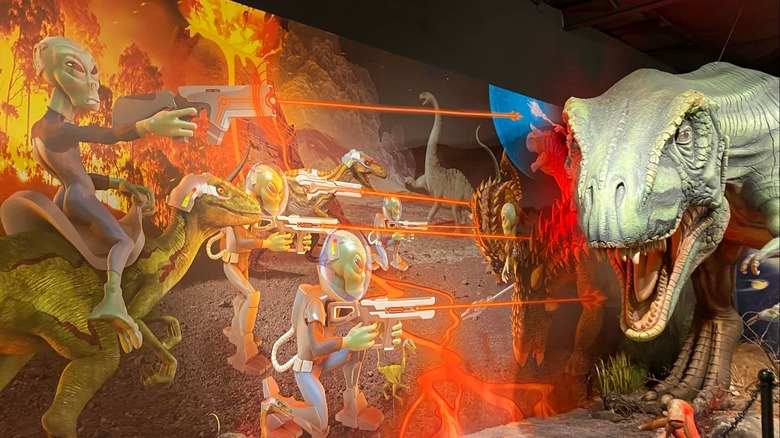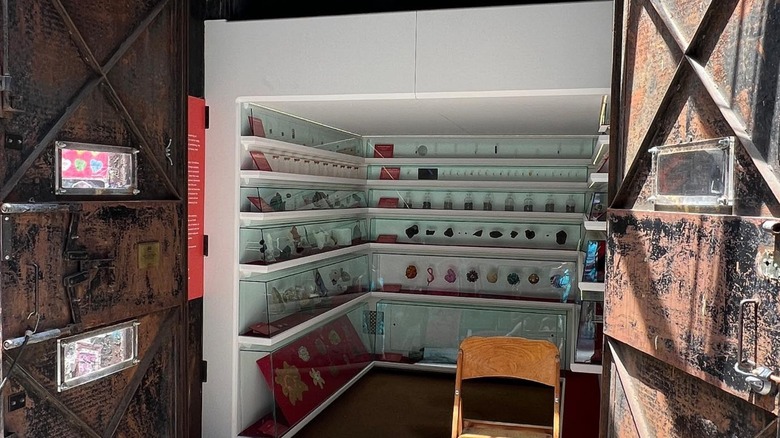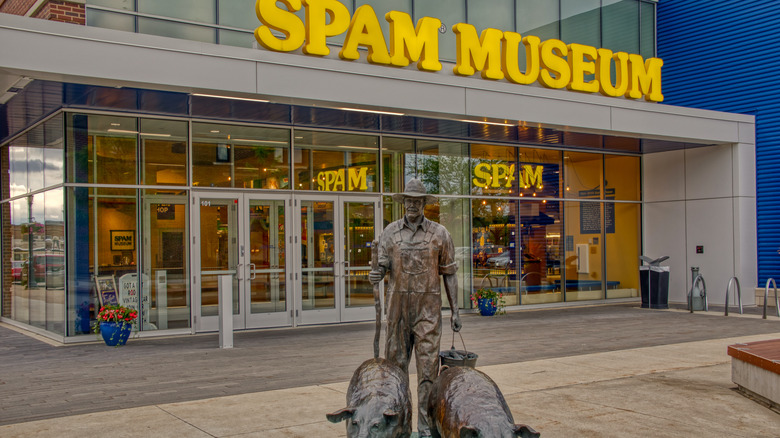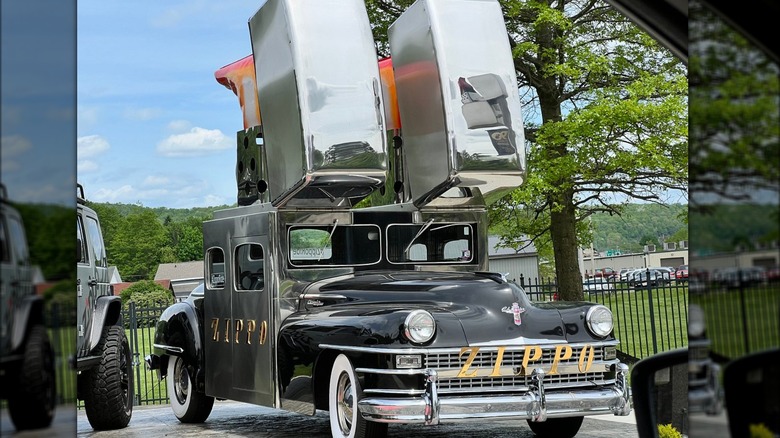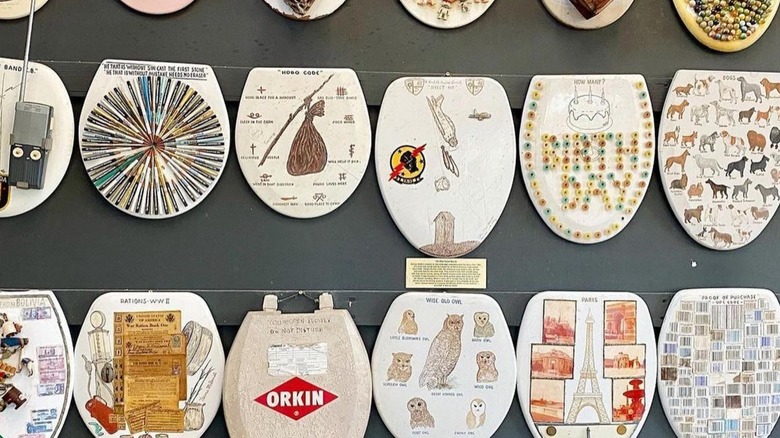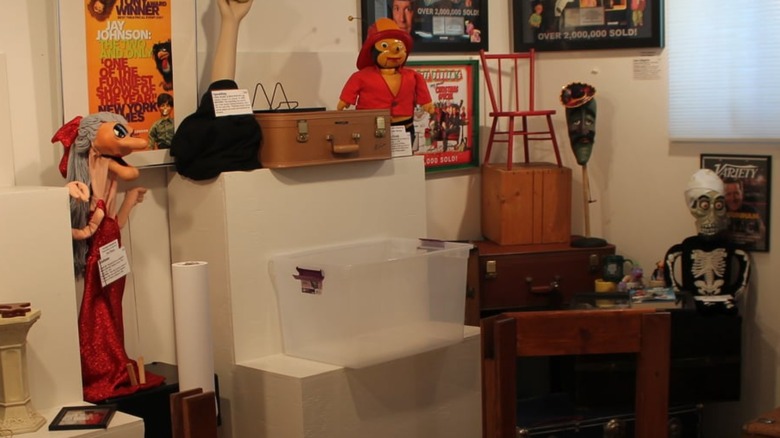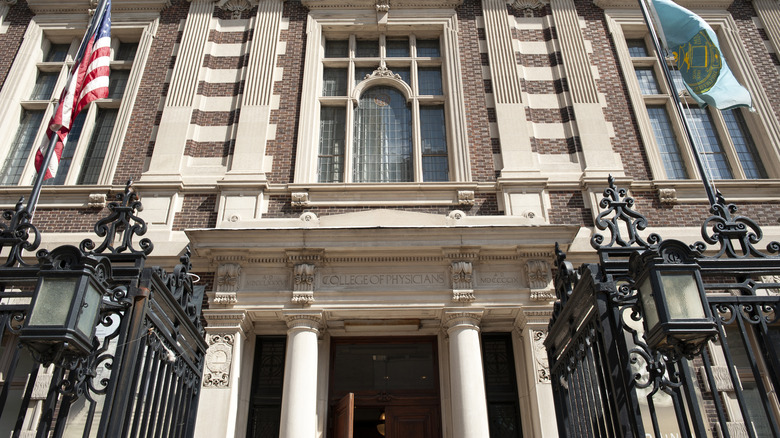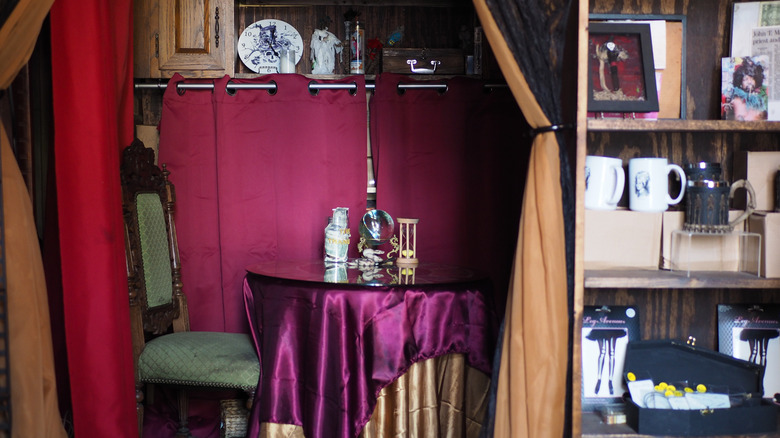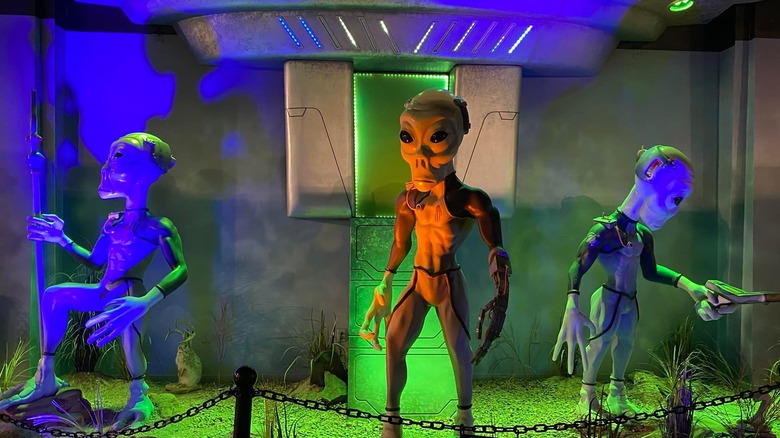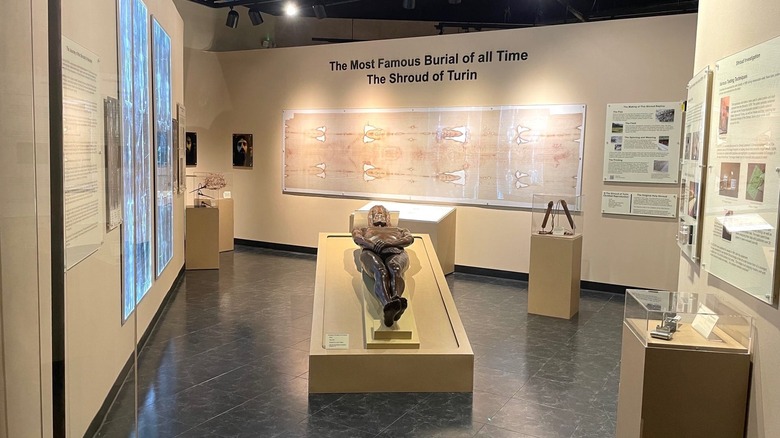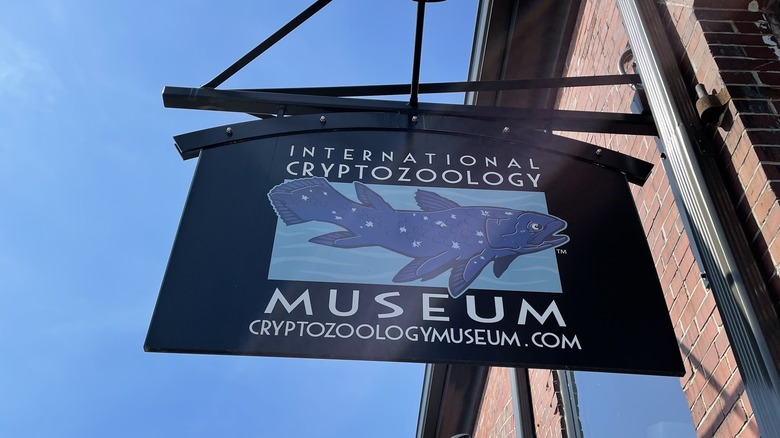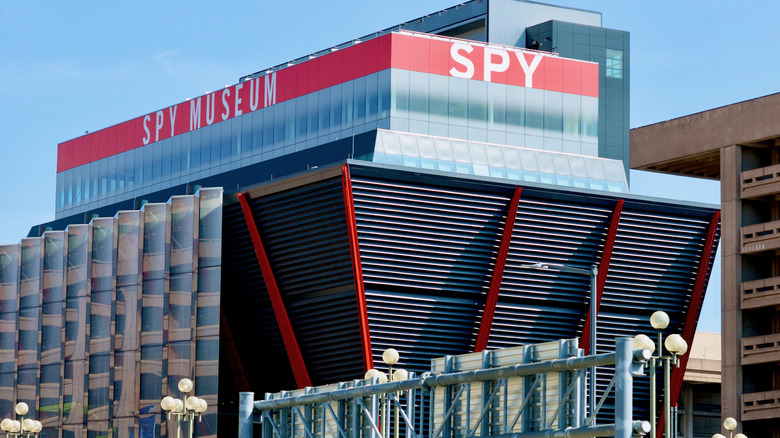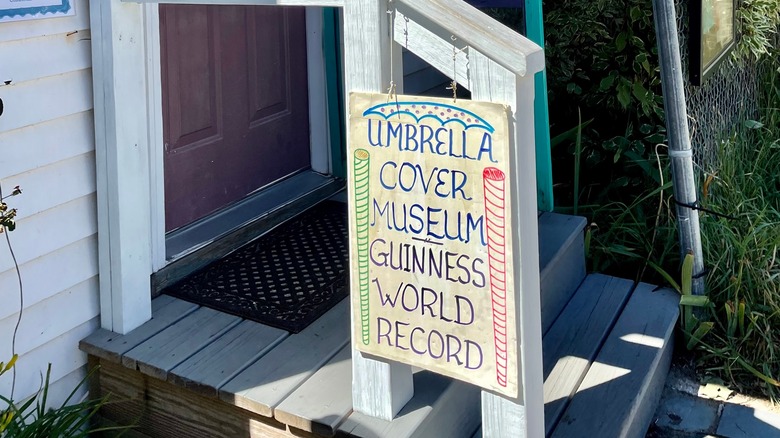Most Bizarre Museums In The United States
Whether you're taking the Great American Road Trip down Route 66 or spending a few days in Manhattan, one of the best ways to round out your travel itinerary is to work in a trip to a local museum. Getting lost in a museum is an excuse to explore your surroundings and work in a little culture on your trip — but who said that culture had to be refined? While we love a good Van Gogh as much as the next guy, sometimes it's fun to step off the beaten path and explore something just a little campier. And in the land of World's Largest Twine Balls and endless folk art creations, the good news is that the United States has no shortage of quirky or offbeat attractions.
From kitschy collections to exhibitions that delve into darker subject matter, there's a museum for every taste, no matter how obscure. Get ready to get a little weird on your next trip, as we take a look at the most bizarre museums the United States has to offer.
Mmuseumm in New York
If you're curious enough to take a closer look, every object has a story to tell. Allowing contemporary artifacts to tell their own stories is the premise behind Mmuseumm. It's something the museum's curators call "object journalism," a tradition that hearkens back to Victorian curiosity cabinets.
The museum, the brainchild of the creative team behind Red Bucket Films, sprung to life when their landlord invited them to use a storage unit. Envisioning a museum where each artifact was an object free of sentiment and intrinsic artistic value, the trio installed the Mmuseumm in the six-by-six disused freight ground floor elevator space, filling it with everyday objects of curiosity before opening it up to the world. A second space was later added three doors down.
Objects to grace the museum have included packaging from Iranian knockoffs of American fast food restaurants, molotov cocktails, and potato chip bags from around the world. Rotated seasonally, the exhibitions vary wildly, with each offering opportunities to reflect on and experience various themes — often packing their share of gravitas. "Losing Time" presented nothing but clock faces drawn by dementia sufferers, while "Last Meal Receipts" presented receipts from death row inmates' last meals. In "Sara Berman's Closet," artist Maira Kalman, the mother of museum co-founder Alex Kalman, paid tribute to her late mother by recreating her mother Sara's white closet. As the museum operates on donations, admission is free. If you show up after hours, the museum offers peepholes, so you don't have to miss out.
SPAM Museum in Austin, Minnesota
Few canned foods have as complex, divisive, and near-mythical an oral history as SPAM, the processed meat with a geometrically satisfying shape and its own cult following. A symbol of American gusto, resilience, and ingenuity, SPAM first emerged during the Great Depression like a porcine phoenix rising from the ashes of a burning economy. The inspired, shelf-stable creation of meat nepo-baby Jay Hormel, SPAM was a futuristic food with a surprisingly simple recipe of pork shoulder, potato starch, salt, sugar, water, and sodium nitrate. It would rise to new glory during World War II, much to the chagrin of SPAM-weary soldiers who called it "ham that didn't pass its physical." Today, the SPAM Museum serves as a tribute to this controversial meat whose popularity has ebbed and flowed throughout its more than eighty-year lifespan.
Fans of SPAM will be delighted to learn admission to the museum, which hosts around 115,000 visitors each year, is completely free. The museum takes about an hour to go through, give or take. Exhibits include a historic Hormel market, a children's play zone, musical instruments made from SPAM cans, and a World Market that highlights SPAM's popularity in places like Japan, the Philippines, and England. Courtesy of its friendly SPAM-bassadors, the SPAM Museum offers free guided tours upon request as well as free live virtual tours.
Zippo/Case Museum in Bradford, Pennsylvania
Like SPAM, Zippo is one of those iconic American brands with a well-deserved cult following thanks in large part to its use by the military during World War II. Small, slick, and minimalist, it's hard to imagine any classic detective film without one of these classy reusable metallic lighters that first emerged in 1930s Pennsylvania. After the war ended, the company took their show on the road with a Zippo Car, the fliptop answer to Oscar Meyer's Weinermobile. Fans can pay tribute to the essential accessory by stopping by the flagship store of Zippo lighters and Case knives, which houses a 15,000-square-foot museum as well as the Zippo Repair Clinic. Much like the Kiss-shaped street lamps of Hershey, Pennsylvania, the drive outside of the museum is lined with fourteen Zippo-shaped street lamps.
In the grand American tradition of oversized objects, the Zippo/Case Museum building features a 40-foot Zippo lighter complete with a glowing neon flame that's visible from the highway. Case is also represented with a giant pocket knife. Guests can also check out the Zippo and Case vehicles before stepping into the museum. A self-guided tour through the attraction presents the history and pop culture impact of both Zippo lighters and Case knives. It is completely free to visit and can be explored in the span of an hour or two, with guests on Tripadvisor noting the museum's many Instagram-worthy spots.
Barney Smith's Toilet Seat Art Museum in The Colony, Texas
San Antonio local Barney Smith had one great love in life: decorative toilet seats. While it might seem like an odd interest, Smith's toilet seat art collection makes more sense in light of his bio as an artist who spent decades working as a master plumber. As a child growing up during the '20s and '30s, Smith was drawn to the art world, sketching countless comics he would display around his childhood home. Despite his passion, Smith dutifully went into the family business. But he never left that artistic spirit behind. When, one fateful day in a plumbing supply house, he came across 50 toilet seats bound for the landfill, he realized he had found his new medium. Using everything from doll heads to coins to calligraphy, Smith finished toilet seat after toilet seat, ultimately amassing a collection of more than a thousand.
The artist opened his collection (then housed in his garage) to the public during the 1990s. These days, the extensive collection resides at Truck Yard The Colony, an outdoor hangout and food truck garden where folks show up with their dogs in tow to check out some live music and relax with a cold brew. The toilet seats are on display for anyone who stops by, and it's completely free to check them out.
Vent Haven Museum of Ventriloquism in Fort Mitchell, Kentucky
Depending on your relationship with ventriloquist dummies (and potentially the type of nightmare fuel you watched growing up), Vent Haven will either delight you or haunt your dreams. The museum exists thanks to one William Shakespeare "W.S." Berger, a colorful character who discovered his love of ventriloquist dummies with his first purchase in 1910 of a character named Tommy Baloney. A hard worker who rose from mailroom clerk to president of Cambridge Tile Company during his career, Berger devoted his free time to amateur ventriloquism, a hobby that included running the International Brotherhood of Ventriloquists and amassing a growing collection of puppets, dummies, and various memorabilia.
Today, guests can share in Berger's love of the whimsical figures at Vent Haven. The museum's extensive dummy collection features characters from around the world dating back to the 19th century, along with posters, recordings, scripts, photos, playbills, and more. Although tours are available by appointment only, reviewers on sites like Tripadvisor rave about the current curator's expertise, charisma, and audience engagement, suggesting it's well worth the small donation and time it takes to schedule one. Set aside about two hours for your visit.
The Mütter Museum of the Human Body in Philadelphia
If you're curious about science or the generally odd and you have a strong stomach, Philadelphia's Mütter Museum offers an interesting look at the human body in a Victorian medical school setting. Founded posthumously on a donation from surgeon Thomas Dent Mütter as part of his commitment to boost medical education in the United States, the museum first rolled out in 1863 and has continued to expand in size ever since. Despite a move in 1909, the Mütter Museum still maintains its original 19th-century cases.
Inside the museum, visitors will find an extensive collection of artifacts, anatomical specimens, historical medical instruments, and various other items pertaining to medicine and human anatomy. Most items housed within the museum originate from the 19th to early 20th centuries, but peruse long enough and you'll encounter a few pieces dating back to the seventh century BCE. One highlight of the museum's permanent collection is a collection of skulls acquired by Viennese anatomist Josef Hyrtl as part of his efforts to refute the then-popular pseudoscience of phrenology.
There's the body of the 18th-century yellow fever victim dubbed "The Soap Lady," an exhibition dedicated to human skin, and a collection of 2,374 foreign bodies removed by Philadelphia otolaryngologist Chevalier Jackson during his tenure. For medical students, artists, and the intellectually curious, Mütter Museum offers a lo-fi, high-interest experience. But sensitive viewers beware: As Tripadvisor reviewer John L. of London noted, "It'd give kids nightmares."
New Orleans Voodoo Museum in New Orleans
Among the many things that give New Orleans a flavor so distinct it almost feels like its own little country is the city's association with voodoo. The New Orleans Voodoo Museum aims to provide an insightful look at the history of voodoo in New Orleans and some of the stories and legends associated with that history. A fairly small museum located in the French Quarter, the museum takes up just two rooms but is packed full of information for anyone with a curious mind.
The self-guided tour is literature-heavy. For guests who lack the patience or youthful eyesight to read through everything or simply want to take a deep dive into the history of voodoo, an optional tour is available. Inside the museum, explore art, voodoo relics, and related artifacts. After a trip through the museum, the tour guide treats guests to an educational stroll through the French Quarter that takes you past Marie Laveau's house and ends at Armstrong Park's Congo Square area, where enslaved people would gather to participate in voodoo ceremonies. For best results, go early in the day and arrive with enough time to review the museum on your own before the tour starts. Be sure to call at least 24 hours in advance if you're planning to take the tour.
The Thing Museum in Benson, Arizona
The drunk uncle of all roadside attractions, the Thing Museum is part sideshow relic, part Fox Mulder fever dream, and all wonderful. The wacky endeavor began with the artisanship of an unusual craftsman. A native of Poetry, Texas, Homer Tate was born in 1884 and managed to live a fairly ordinary (if interesting) life of mining, farming, and ascension to small-town sheriff before finding his strange calling as an artist. Like toilet seat virtuoso Barney Smith, Tate found himself drawn to an unusual art form — in his case, creating the types of ersatz specimens, chimeras, mummies, and cryptids found in carnival sideshows, lovingly crafting his papier-mache originals using hair swept from salon floors or bones salvaged from the desert.
One such exhibit made it into the hands of lawyer Thomas Binkley Prince, who used it as the centerpiece for his roadside attraction, enveloping it in increasingly complex lore as the "mystery of the desert" known as "The Thing." Through the years, the exhibit has expanded to a whopping 13,000 square feet, weaving together conspiracy theories that make QAnon look positively prosaic. This place has everything: aliens, dinosaurs, even Elvis. And for only a few bucks per person, it's well worth the price of admission.
National Museum of Funeral History in Texas
Founded in 1992 to educate the public about one of humanity's oldest traditions and shine a light on the compassion and commitment of death care industry workers, the National Museum of Funeral History has continued to expand through the years. Today, it encompasses more than 30,500 square feet and serves as the United States' foremost educational center on the subject of funeral and death customs.
The expansive museum's 19 permanent exhibitions cover a wide range of death practice-related topics. "History of Embalming" explores embalming rituals dating back to ancient history. An exhibition on Japanese funeral customs and industry explores funeral customs and culture in a country where memorial services can become exorbitant in cost. Learn about papal and presidential funerary rites, experience the world of Victorian mourning, and explore the museum's collection of caskets, coffins, and hearses. The museum even features presentations on Día de Muertos and New Orleans jazz funerals.
For lovers of the dark and macabre, the National Museum of Funeral History is a must-see attraction, but it's far from creepy. The tastefully presented content is engaging and sensitive enough to provide a couple of hours' worth of quality edutainment for families with older youths and teens.
International Cryptozoology Museum in Portland, Maine and Bangor, Maine
For anyone who has ever dreamed of finding Bigfoot but lacks the constitution for conducting stakeouts deep in the American wilderness or sneaking onto Skinwalker Ranch, the International Cryptozoology Museum has you covered. Founded in 2003 by cryptozoologist and writer Loren Coleman from his personal collection of cryptid artifacts and curiosities, the museum has since expanded to two locations.
Hardened skeptics and visitors without much of a sense of humor tend not to love it, but anyone willing to go with the flow and appreciate it for the roadside attraction it is will have a good time. It's also popular among youth and teens, and the museum takes its role as a gateway experience into the world of science seriously. While the smallish museum is short on concrete evidence, it has enough interesting information on its subject matter to keep fans of the field entertained for an hour or two. A long list of cryptids is covered far beyond Bigfoot and Sasquatch — you'll also find information on the Skunk Apes, the Jersey Devil, the Dover Demon, the Abominable Snowman, and Yowie, just to name a few.
International Spy Museum in Washington, DC
Aspiring 007s will have a blast at D.C.'s International Spy Museum. The nonprofit museum, which aims to present artifacts and history related to the world of espionage in an apolitical forum, is a little on the spendy side but features enough interesting and well-presented content to easily knock out an afternoon. In the "Covert Action" gallery, guests will find historical tools of spycraft like artifacts of deception, from forgery tools to illusionists' tricks, and information on propaganda, exfiltration, and lethal action. Another gallery explores the historical role of espionage from the American Revolution to World War II and the world of cyber espionage we're facing today. In the "Undercover Mission" gallery, visitors get a chance to experience spycraft firsthand with hands-on digital stations meant to put their own spy skills to the test.
Although fairly interactive and engaging, the museum can be a pretty history-dense experience and may be best suited for older children and adults. If you're the type of person who likes to take their time, be sure to set aside at least three hours to work your way through the museum's upper galleries. Timed passes help with crowd control, but it can get hectic as the day wears on, so be prepared to face fairly thick crowds if you come later in the day.
Umbrella Cover Museum in Peaks Island, Maine
If ever a museum embodied the "waste not, want not" ethos, it's Maine's Umbrella Cover Museum. Perhaps unsurprising for a woman with a numerical name, museum curator Nancy 3. Hoffman has a strange affection for the mundane. Not long after a housecleaning sesh revealed she had inadvertently been hoarding umbrella covers — around seven of them – she found herself compelled to steal another one from a dime store. Apparently, things continued to snowball until the collection outgrew her kitchen, blossoming into a full-blown umbrella cover museum. After winning a Guinness World Record in 2012 with a whopping 730 covers, Nancy 3's collection clocks in at more than 2,000 today, with umbrella covers representing 71 countries.
Although the museum is small and getting there requires a 20-minute ferry ride and a short walk from the Peaks landing, reviewers on Tripadvisor insist it's worth the diversion, citing Nancy 3's charming personality and apparent accordion skills. As one guest put it, "I'm happy to live in a world where someone had the idea to create this tiny, quirky museum." If you're planning to visit, it probably can't hurt to sacrifice an umbrella cover to Nancy 3's cause — just try not to steal it.
